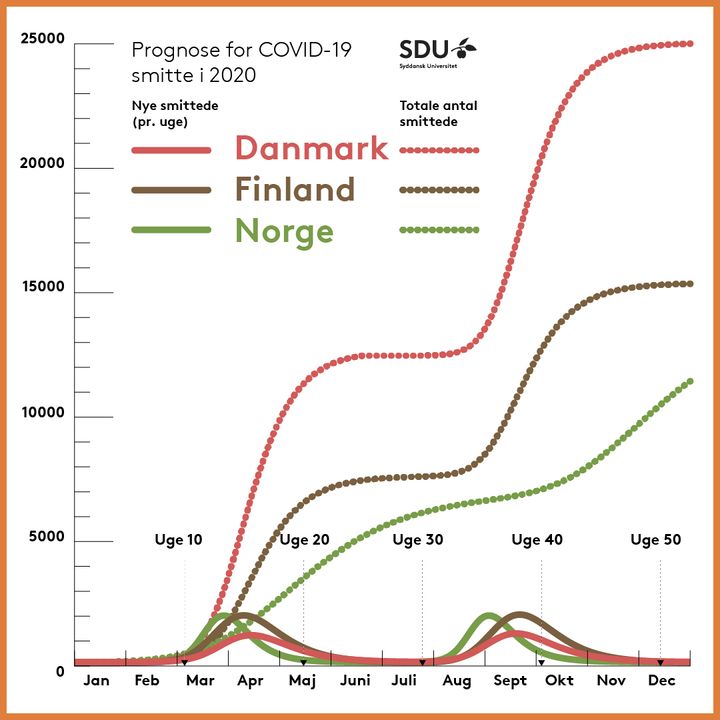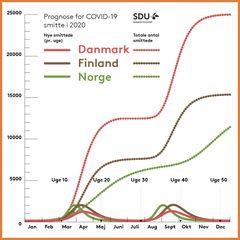Covid 19: The next wave is on its way in Europe and it may be similar to the first

Around week 32-48, Europe risks being hit by a new wave of Covid 19, which could be as strong as the first to hit the continent in the spring.
This is predicted by Professor of Theoretical Physics, Francesco Sannino from the University of Southern Denmark. Together with colleagues Giacomo Cacciapaglia and Corentin Cot from the University of Lyons in France, he has developed a model that now projects the Covid 19 development in Europe for the rest of the year 2020.
- Our simulation shows that we will face a similar number of infected as in the spring if we take the same precautions for social distance and introduce the same restrictions as we did during the first wave. If we do not do that, we risk even more infections, he says.
Interplay with other regions of the world
According to the model the second wave in Europe will start at different times in different countries after week 32 and will fade after a few weeks. Same course as during the first wave, if precautions and restrictions are the same. Only after week 50 will the number of new infected again be as low as before week 30, when they slowly began to rise again.
The simulation is based on Covid 19 data from around the world and especially from the first wave. The scientific method of calculation is rooted in the methods of particle physics and is an extension of the ones used by epidemologists use to simulate the diseases dynamics within a country.
It determines the onset timing of the second wave due to the interplay with other regions of the world. The number of infected is based on the first wave including those that are not registered.
May vary up to 14 days
After feeding the model with data, the researchers performed hundreds of simulations, each of which differs in terms of the human exchange across different European regions and the rest of the world affecting the onset and peak of the next wave.
The results as they are presented here are, in the case of the onsets, an average - it is therefore possible that the onsets and peaks may occur a few days (perhaps up to 14 days) before or after those stated here.
- But the model leaves no doubt that another, equally extensive wave will come if we do not tighten the measures that currently apply, says Francesco Sannino.
European countries in the model
A premise of the model is also that there is no herd immunity.
The countries included in the model are Austria, Belgium, Croatia, Denmark, Finland, France, Germany, Greece, Hungary, Ireland, Italy, the Netherlands, Norway, Poland, Slovakia, Spain, Switzerland and the United Kingdom.
Most of them are expected to be hit by new Covid 19 waves in periods between September and December, especially between weeks 32 and 48.
Prepare and implement necessary measures
- Our model can be used by governments, the industry, citizens and the financial market to prepare and implement necessary local and global measures before the next wave hits, says Francesco Sannino.
Francesco Sannino and colleagues presented a similar model in the spring 2020. Link: https://www.sdu.dk/da/om_sdu/fakulteterne/naturvidenskab/nyheder-2020/coronavirus
The scientific model and the results are described in the scientific article Second wave COVID-19 pandemics in Europe: A Temporal Playbook, which is currently undergoing a so-called peer review, where scientific peers review the article and assess the quality of the research.
See the forecast for the whole of Europe in this animation: https://www.youtube.com/watch?v=qbC3_uekkBE
Keywords
Contacts
Professor Francesco Sannino is a theoretical physicist at Department of Physics, Chemistry and Pharmacy at University of Southern Denmark. He is head of Centre for Cosmology and Particle Physics Phenomenology. mail: sannino@cp3.sdu. Phone: +45 2135 6088.
Press officer Birgitte Svennevig, Faculty of Science, University of Southern Denmark. birs@sdu.dk +45 2759 8679.
Images

Links
About Syddansk Universitet
Subscribe to releases from Syddansk Universitet
Subscribe to all the latest releases from Syddansk Universitet by registering your e-mail address below. You can unsubscribe at any time.
Latest releases from Syddansk Universitet
Yousif Subhi udnævnt til professor i øjensygdomme ved SDU19.12.2025 11:26:25 CET | Pressemeddelelse
Professoratet skal styrke forskningen i patientnære løsninger og ny teknologi til behandling af nethindesygdomme og bidrage til udvikling, kvalitet og ny viden på området.
SDU vil styrke fremtidens sundhedsvæsen med ny kandidatuddannelse i sundhedsøkonomi19.12.2025 10:07:21 CET | Pressemeddelelse
Syddansk Universitet vil fra sommeren 2026 udbyde en ny kandidatuddannelse i sundhedsøkonomi. Uddannelsen skal imødekomme et voksende behov for specialiseret viden om økonomi i sundheds- og velfærdsområdet.
Benjamin S. B. Rasmussen udnævnt til professor i radiologi og medicinsk teknologi ved SDU15.12.2025 14:03:46 CET | Pressemeddelelse
Professoratet skal styrke forskningen i medicinsk teknologi og bidrage til udvikling, kvalitet og ny viden på området.
194.000 har fortalt om bevægelsesvaner11.12.2025 10:32:04 CET | Pressemeddelelse
Danmark i Bevægelse har nu et unikt datamateriale, som kan bruges til at skabe bedre rammer for et aktivt liv for børn og voksne.
ERC-millioner til professor Rafsanjani: Slangerobot skal lytte sig frem i ukendt terræn9.12.2025 12:10:30 CET | Pressemeddelelse
Professor Ahmad Rafsanjani har netop modtaget en prestigefuld ERC-bevilling på 15 millioner kroner. Hans projekt vil lære bløde robotter at navigere ved hjælp af lyd, friktion og origami-teknik – en evne, der kan åbne døre til både sammenstyrtede bygninger og fjerne planeter.
In our pressroom you can read all our latest releases, find our press contacts, images, documents and other relevant information about us.
Visit our pressroom